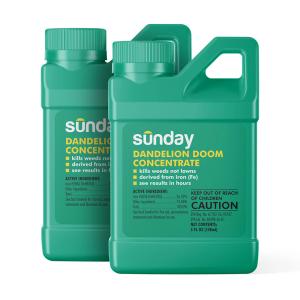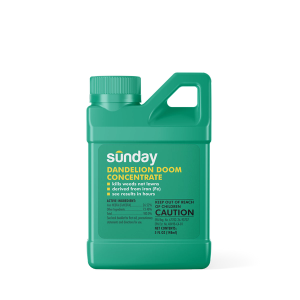Why weeds cause issues in lawns
Ever heard the saying "growing like a weed"? In your lawn, an abundance of weeds creates a serious challenge because weeds are naturally equipped to outcompete grass:
- Weeds produce seeds rapidly, disperse them widely, and can tolerate less desirable conditions than grass
- Weed seeds can remain viable in the soil for years, waiting for the right opportunity to germinate and spread
By their nature, they will always be able to steal resources from the grass in your lawn, causing bare patches and thinning if not properly managed.
Sunday Tip:
Not all weeds are bad. Some have positive qualities, including serving as early-flowering plants for pollinators in spring when other options are limited.
How to win the weedy lawn battle
When dealing with a severely weed-infested lawn (~40-50% weeds), success requires a specialized approach. The key is using a combination of strategic mowing and heavy repair overseeding. This targeted method creates conditions where grass seedlings can establish despite a challenging environment.
Meaning, unlike standard overseeding or simple weed control, this approach focuses on giving your grass seed the best chance to germinate and establish in an environment dominated by competing weeds.
Sunday Tip:
Selecting grass seed suited specifically for your lawn's conditions is the Sunday way to grow a lawn that can effectively outcompete weeds without excessive chemical intervention. Find the best Sunday grass seed for your lawn
The best method for heavily weeded lawns: Mow low and then seed
When dealing with a lawn that is almost entirely covered with weeds, this specialized technique provides the best results:
Mow your lawn SHORT
In a very heavily weeded lawn, start by mowing 1-2 inches shorter than usual. This simultaneously cuts back growing weeds and opens the grass canopy, allowing grass seeds to reach the soil below.
Sunday Tip:
This critical first step creates small spaces where your new grass seed can make direct contact with soil and successfully germinate.
Seed at the highest rate
Once the seeds have access to the soil below, seed heavily at the highest recommended rate for your Sunday grass type:
- Fescue Rescue: 8 lbs./1000 sq. ft.
- Pet Lawn: 8 lbs./1000 sq. ft.
- Shade Select: 5 lbs./1000 sq. ft.
- Lucky Lawn: 5 lbs./1000 sq. ft.
- Kentucky's Best: 2 lb./1000 sq. ft.
- Bermuda Time: 1 lb./1000 sq. ft.
Psst. Check out Sunday's instructions on how to seed your lawn.
Mow short again
A week or so after seeding, mow short again to cut back any new weed growth. This second low mowing is crucial - it prevents fast-growing weeds from shadowing your emerging grass seedlings.
Once the new seed has germinated, stay off the grass to avoid damaging the delicate new growth until your first regular mow.
This approach works by giving your grass seed a competitive advantage through timing and density, rather than relying solely on eliminating weeds first.
Critical post-seeding care for weedy lawns
Once the grass seed hits the ground, proper seed care is essential for success in a weed-dominated environment:
- For successful germination, grass seed needs consistent moisture. Keep the seeded areas evenly moist for at least 10 days (or more!), or until you see at least ¾ inch of growth. In heavily weeded lawns, you may need to water more frequently than in traditional overseeding, as established weeds will compete aggressively for available moisture.
- You can continue mowing weeds at a low setting before germination, but be extremely careful not to disrupt the newly seeded area once seeds start sprouting. Reducing foot traffic is especially important in weedy areas, as traffic can push new seedlings deeper into the weed canopy where they receive insufficient light.
Remember that transforming a severely weedy lawn requires patience. A very weedy lawn will take a couple of years of repeated overseeding, strategic mowing, and consistent care to outcompete the majority of weeds fully.
Addressing the real problems beneath the weeds
Several factors contribute to the aggressive growth of weeds in lawns. Everything from soil compaction to poor drainage, inadequate nutrition, and general lawn stress can lead to an overly weedy lawn. The secret to long-term success lies in looking beyond the immediate issues and identifying the underlying causes. After all, lawn health begins in the soil.
After your initial seeding efforts begin to establish, consider soil testing and custom lawn care to create conditions that naturally favor grass over weeds. Your lawn will thank you with thicker, more resilient growth that naturally keeps weeds at bay.
Let's get growing
Our lawn engine uses satellite data to map out your lawn size and determine things like average rainfall, common weeds, and pest activity.
Related lawn seeding resources
Looking to expand your seeding knowledge? Check out Sunday seed guides:
- Overseeding Your Lawn - Learn the fundamentals of overseeding to thicken existing turf
- Sunday Grass Seed Guide - Explore our comprehensive resources on different seed varieties and techniques
Sunday Tip:
Whether you're dealing with specific weeds, challenging soil conditions, or simply want to improve your existing lawn, Sunday lawn care guides provide science-backed guidance for creating a healthier outdoor space.




















